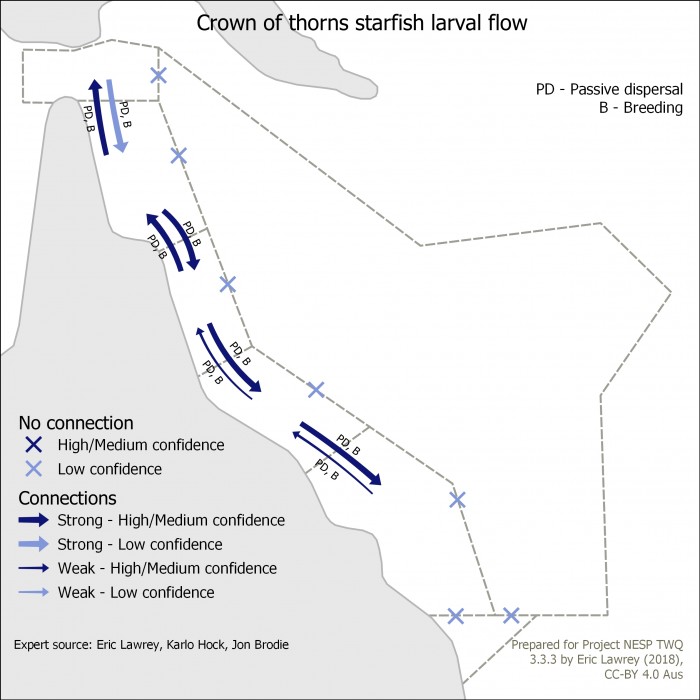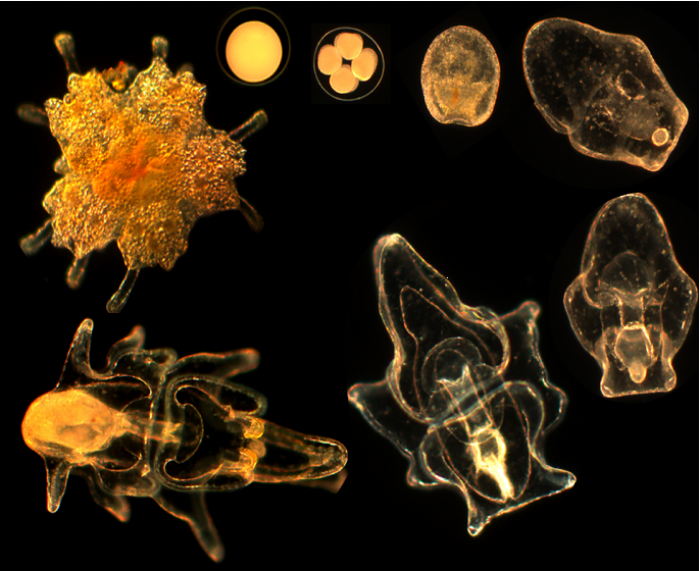Crown of thorns starfish larval flow
In the past 50 years, four waves of crown-of-thorns starfish outbreaks have had a major impact on the many reefs that make up the Great Barrier Reef. These began in 1962, 1979, 1993 and 2009 with each wave lasting about 15 years (Babcock et al. 2016; Pratchett et al. 2017).
Crown-of-thorns starfish (also known as COTS) are marine invertebrates that feed on coral. They occur naturally on reefs throughout the Indo-Pacific region, and when conditions are right, they can reach plague proportions that devastate hard coral communities.
Key concepts that relate to its connectivity
During summer months adult crown-of-thorns starfish spawn. Each female can release 10’s millions of eggs (Caballes et al. 2016), resulting in huge quantities of larvae that drift in the ocean current (Uthicke et al. 2015). The larvae are ready to settle after about 11 days of development (Pratchett et al. 2017) during which they rely on phytoplankton for food (Brodie et al. 2005)). If the larvae don’t find a reef they can continue to drift for several more weeks before they die (Pratchett et al. 2017)). This allows the larvae settle on reefs 100’s of kilometres from their parents.
Once settled the juvenile crown-of-thorns starfish can reach adulthood in 2 years where if there are enough of them they will form a new outbreak.
Historically the initial outbreaks have been detected between Cairns and Lizard Island (Wooldridge and Brodie 2015). They then slow spread down the coast over a 15 year period where they finally dissipate off the coast from the Mackay.
The outbreaks also occur in the reefs in far north Queensland, the Swains Reefs, the Capricorn-Bunkers and Torres Strait, however far less is known about the patterns of outbreaks due to a lack of surveys in these regions. Outbreaks are not known to occur in the Coral Sea reefs, however no regular surveys have conducted.
The crown-of-thorns starfish larvae feed on phytoplankton in the water column (Okaji 1997) and so additional nutrients from rivers runoff are thought to contribute to an increase in the survival rate of larvae (Brodie et al. 2005; Fabricius et al. 2010) and the frequency of outbreaks (Fabricius et al. 2010). Overfishing of CoTS predators may also play a role in the frequency and severity of outbreaks (Cowan et al. 2017).
References
Pratchett, M.S., Caballes, C.F., Wilmes, J.C., Matthews, S., Mellin, C., Sweatman, H.P., Nadler, L.E., Brodie, J., Thompson, C.A., Hoey, J. and Bos, A.R., 2017. 30 Years of Research on Crown-of-thorns Starfish (1986-2016): Scientific Advances and Emerging Opportunities. Diversity 9, 41. doi:10.3390/d9040041. https://www.mdpi.com/1424-2818/9/4/41
Brodie, J., Devlin, M., Lewis, S. 2017. Potential Enhanced Survivorship of Crown of Thorns Starfish Larvae due to Near-Annual Nutrient Enrichment during Secondary Outbreaks on the Central Mid-Shelf of the Great Barrier Reef, Australia. Diversity 9, 17. doi:10.3390/d9010017. https://www.mdpi.com/1424-2818/9/1/17
Wooldridge, S., Brodie, J. 2015. Environmental triggers for primary outbreaks of crown-of-thorns starfish on the Great Barrier Reef, Australia. Marine Pollution Bulletin 101, 805 – 815.
Cowan, Z.-L.; Pratchett, M.S.; Messmer, V.; Ling, S.D. Known predators of crown-of-thorns starfish (Acanthaster spp.) and their role in mitigating, if not preventing, population outbreaks. Diversity 2017, 9, 7.
Brodie, J.E.; Fabricius, K.E.; De’ath, G.; Okaji, K. Are increased nutrient inputs responsible for more outbreaks of crown-of-thorns starfish? An appraisal of the evidence. Mar. Pollut. Bull. 2005, 51, 266–278.
Fabricius, K.E.; Okaji, K.; De’ath, G. Three lines of evidence to link outbreaks of the crown-of-thorns seastar Acanthaster planci to the release of larval food limitation. Coral Reefs 2010, 29, 593–605.
Caballes, C.F.; Pratchett, M.S.; Kerr, A.M.; Rivera-Posada, J.A. The role of maternal nutrition on oocyte size and quality, with respect to early larval development in the coral-eating starfish, Acanthaster planci. PLoS ONE 2016, 11, e0158007.
Uthicke, S.; Doyle, J.R.; Duggan, S.; Yasuda, N.; McKinnon, A.D. Outbreak of coral-eating Crown-of-Thorns creates continuous cloud of larvae over 320 km of the Great Barrier Reef. Sci. Rep. 2015, 5, 16885.
Babcock, R.C.; Dambacher, J.M.; Morello, E.B.; Plagányi, É.E.; Hayes, K.R.; Sweatman, H.P.A.; Pratchett, M.S. Assessing different causes of crown-of-thorns starfish outbreaks and appropriate responses for management on the Great Barrier Reef. PLoS ONE 2016, 11, e0169048.
Okaji, K., Ayukai, T. & Lucas, J. (1997) Selective feeding by larvae of the crown-of-thorns starfish,Acanthaster planci (L.). Coral Reefs 16: 47. https://doi.org/10.1007/s00338005005
Wolanski, E. (2016) Bounded and unbounded boundaries – Untangling mechanisms for estuarine-marine ecological connectivity: Scales of m to 10,000 km – A review. Estuarine, Coastal and Shelf Science, Volume 198, Part B, Pages 378-392, https://doi.org/10.1016/j.ecss.2016.06.022








